

Cuirassier. French cuirassier (1809) Cuirassiers (/ˌkwɪrəˈsɪər/, from French cuirassier,[1] pronounced: [kɥiʁasje]) were mounted cavalry soldiers equipped with armour and firearms, first appearing in late 15th-century Europe.
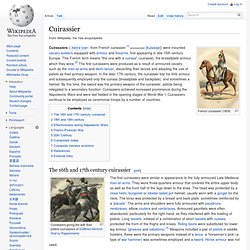
Royal Saxon Army. Royal Saxon Army. History of Saxony. The history of Saxony concerns what was originally a small tribe living on the North Sea between the Elbe and Eider Rivers in the present Holstein.
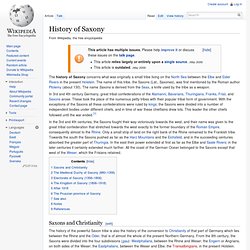
The name of this tribe, the Saxons (Lat., Saxones), was first mentioned by the Roman author Ptolemy (about 130). The name Saxons is derived from the Seax, a knife used by the tribe as a weapon. In 3rd and 4th century Germany, great tribal confederations of the Alamanni, Bavarians, Thuringians, Franks, Frisii, and Saxons arose. Kingdom of Saxony. The Napoleonic Era and the German Confederation[edit] Before 1806 Saxony was part of the Holy Roman Empire, a thousand-year-old entity which had once aspired to be a single state, but had become highly decentralised over the centuries.
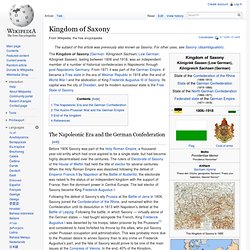
Saxe-Weimar-Eisenach. The Duchy of Saxe-Weimar-Eisenach (German: Herzogtum Sachsen-Weimar-Eisenach) was created in 1809 by the merger of the Ernestine duchies of Saxe-Weimar and Saxe-Eisenach.
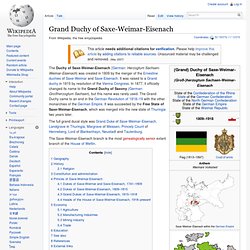
It was raised to a Grand duchy in 1815 by resolution of the Vienna Congress. In 1877, it officially changed its name to the Grand Duchy of Saxony (German: Großherzogtum Sachsen), but this name was rarely used. Battle of Königgrätz. The Battle of Königgrätz (German: Schlacht bei Königgrätz), also known as the Battle of Sadowa, Sadová, or Hradec Králové, was the decisive battle of the Austro-Prussian War, in which the Kingdom of Prussia defeated the Austrian Empire.

Taking place near Königgrätz (Hradec Králové) and Sadowa (Sadová) in Bohemia on 3 July 1866, it was an example of battlefield concentration, a convergence of multiple units at the same location to trap and/or destroy an enemy force between them. Preliminary campaign[edit] The reluctant Austrian commander Benedek had moved his troops out of their staging point at Olmütz only on 18 June, moving north in three parallel columns with the I Corps protecting the right flank. The Austrians took up positions at the fortress Josefstadt and the mountain passes from Saxony and Silesia.[2] Fortunately for Prussia, Benedek was indecisive and failed to use his superior numbers to eliminate the Prussian armies individually. Preussische Militärgeschichte - Historischer Service.
Unification of Germany. Untitled. German General Staff. The German General Staff, originally the Prussian General Staff and officially Great General Staff (Großer Generalstab), was a full-time body at the head of the Prussian Army and later, the German Army, responsible for the continuous study of all aspects of war, and for drawing up and reviewing plans for mobilization or campaign.
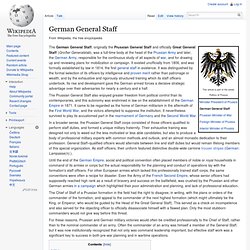
It existed unofficially from 1806, and was formally established by law in 1814, the first general staff in existence. It was distinguished by the formal selection of its officers by intelligence and proven merit rather than patronage or wealth, and by the exhaustive and rigorously structured training which its staff officers undertook. Its rise and development gave the German armed forces a decisive strategic advantage over their adversaries for nearly a century and a half. In a broader sense, the Prussian General Staff corps consisted of those officers qualified to perform staff duties, and formed a unique military fraternity. History[edit] Nuremberg Laws. Title page of RGB I No. 100 proclaiming the laws.
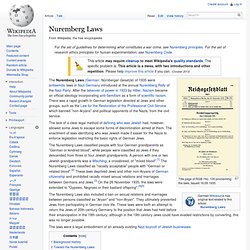
Issued 16.09.1935. Prussian Army. The Royal Prussian Army (German: Königlich Preußische Armee) was the army of the Kingdom of Prussia.
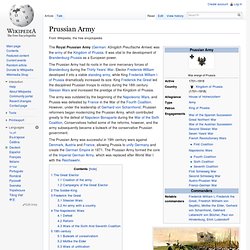
It was vital to the development of Brandenburg-Prussia as a European power. The Prussian Army had its roots in the core mercenary forces of Brandenburg during the Thirty Years' War. Elector Frederick William developed it into a viable standing army, while King Frederick William I of Prussia dramatically increased its size. Adelstitel. Der Adelstitel gab den Rang eines Adligen in der gesellschaftlichen Hierarchie an.
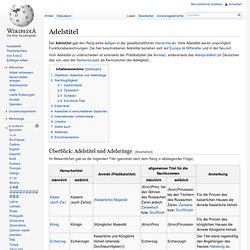
Viele Adelstitel waren ursprünglich Funktionsbezeichnungen. Die hier beschriebenen Adelstitel beziehen sich auf Europa im Mittelalter und in der Neuzeit. Vom Adelstitel zu unterscheiden ist einerseits der Prädikatstitel (die Anrede), andererseits das Adelsprädikat (im Deutschen das von, also der Namenszusatz als Kennzeichen der Adeligkeit). Überblick: Adelstitel und Adelsränge[Bearbeiten] Im Wesentlichen gab es die folgenden Titel (geordnet nach dem Rang in absteigender Folge) Adelsprädikat. Ein Adelsprädikat („Prädikat“ von lateinisch praedicatum ‚Rangbezeichnung‘) ist ein Namenszusatz oder die Anrede für einen Adeligen.
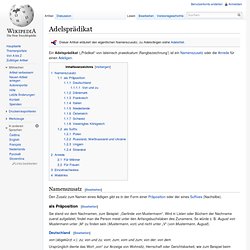
Namenszusatz[Bearbeiten] Den Zusatz zum Namen eines Adligen gibt es in der Form einer Präposition oder der eines Suffixes (Nachsilbe). als Präposition[Bearbeiten] German Empire. The German Empire (German: Deutsches Reich or Deutsches Kaiserreich) was the historical German nation state that existed from the unification of Germany in 1871 to the defeat in World War 1 in 1918, when Germany became a federal republic. The state was the predecessor of today's Germany. The Empire is sometimes called the German Reich[7] (literally: "German Realm"[8][9][10]). Metropolitan regions in Germany. Using a narrower definition of metropolises, only four cities surpass the threshold of at least one million inhabitants, namely: Berlin, Hamburg, Munich and Cologne. Metropolitan regions[edit] Sorted alphabetically: Big five[edit] The five most important regions, collectively often called the "big five",[2][3] are frequently compared with other European metropolitan areas for investments and market development.[4] They are (from north to south): Hamburg, Berlin, Düsseldorf/Cologne, Frankfurt am Main and Munich.
Globalization and World Cities Study Group (GaWC) considers Frankfurt and Munich "α" (Alpha) Global Cities, while the others are considered "β" (Beta) global cities.[5] Each of them forms types of clusters and achieves varying levels of performance in areas such as business activity, human capital, information and technology exchange, cultural experience, and political engagement.[6] List[edit] highest score of all metropolitan regions highest score of all metropolitan areas.
Unification of Germany. States of Germany. Germany is made up of sixteen Länder (singular Land, colloquially called Bundesland, for "federated state"), which are the partly sovereign constituent states of the Federal Republic of Germany. The loan word "Land" (with an uppercase 'L') is used in the official English version of the Basic Law[1] and in UK parliamentary proceedings.[2] However, it is sometimes translated as "federal states" in other publications.[3] Germanic Heroic Age. The Germanic (or "German") Heroic Age, so called in analogy to the Heroic Age of Greek mythology, is the period of early historic or quasi-historic events reflected in Germanic heroic poetry.[1] Periodisation[edit] The period corresponds to the Germanic Wars in terms of historiography, and to the Germanic Iron Age in terms of archaeology, spanning the early centuries of the Common Era, in particular the 4th and 5th centuries, the period of the final collapse of the Western Roman Empire and the establishment of stable "barbarian kingdoms" larger than at the tribal level (the kingdoms of the Visigoths, the Franks and the Burgundians, and the Anglo-Saxon invasion of Britain).
The Germanic peoples at the time lived mostly in pagan tribal societies. Historicity[edit] Germanic mythology combines purely mythological material with historical events of this period. Triumph of the Will. Triumph of the Will (German: Triumph des Willens) is a 1935 film made by Leni Riefenstahl. It chronicles the 1934 Nazi Party Congress in Nuremberg, which was attended by more than 700,000 Nazi supporters.[1] The film contains excerpts from speeches given by Nazi leaders at the Congress, including portions of speeches by Adolf Hitler, Rudolf Hess, and Julius Streicher, interspersed with footage of massed Sturmabteilung and Schutzstaffel troops, and public reaction. Hitler commissioned the film and served as an unofficial executive producer; his name appears in the opening titles.
Lexikon der Wehrmacht. Heer - decal for helmet 1942.svg - Wikipedia, the free encyclopedia. Cancel Edit Delete Preview revert Text of the note (may include Wiki markup) Could not save your note (edit conflict or other problem). Please copy the text in the edit box below and insert it manually by editing this page. Upon submitting the note will be published multi-licensed under the terms of the CC-BY-SA-3.0 license and of the GFDL, versions 1.2, 1.3, or any later version. See our terms of use for more details. Add a note Draw a rectangle onto the image above (press the left mouse button, then drag and release). Save To modify annotations, your browser needs to have the XMLHttpRequest object. [[MediaWiki talk:Gadget-ImageAnnotator.js|Adding image note]]$1 [[MediaWiki talk:Gadget-ImageAnnotator.js|Changing image note]]$1 [[MediaWiki talk:Gadget-ImageAnnotator.js|Removing image note]]$1.
Heinrich Lehmann-Willenbrock. Biography[edit] Lehmann-Willenbrock left U-96 in March 1942 to be promoted to Korvettenkapitän and appointed Flottillenchef of the 9th U-boat Flotilla, stationed in Brest.